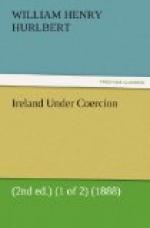It was on the 17th of October 1886 that Mr. John Dillon, M.P., first promulgated the “Plan of Campaign” at Portumna, in a speech which was promptly flashed under the Atlantic to New York, there to feed the flame, already fanned by the eloquence of Dr. M’Glynn, into a blaze of enthusiasm for the apostle of the New Gospel of Confiscation.
Had the “Plan of Campaign” then been met by the highest local authority of the Catholic Church in Ireland, as Henry George’s doctrine of Confiscation was met in New York by Archbishop Corrigan, it might never have been necessary to issue the Papal Decree of April 1888. But while the Bishop of Limerick unhesitatingly denounced the “Plan of Campaign” as “politically stupid and morally wrong,” the Archbishop of Dublin bestowed upon it what may be called a left-handed benediction. Admitting that it empowered one of the parties to a contract to “fix the terms on which that contract should continue in force,” the Archbishop actually condoned the claim of this immoral power by the tenant, on the ground that the same immoral power had been theretofore exercised by the landlord! Peter having robbed Paul from January to July, that is, Paul should be encouraged by his spiritual guides to rob Peter from July to January!
That the Catholic Church should even seem for a time to speak with two voices on such a point as the moral quality of political machinery, or that speaking with one voice upon such a point in America, it should even seem to speak with another voice in Ireland, would clearly be a disaster to the Church and to civilisation. From the moment therefore, in 1886, when the issue between Dr. M’Glynn and the Archbishop of New York was defined, as I have shown, and the Irish National League, with a quasi-indorsement from the Archbishop of Dublin, had arrayed itself practically and openly on the side of Dr. M’Glynn and against the Archbishop of New York, interests far transcending those of any political party in Ireland, in Great Britain, or in the United States, were involved. Unfortunately for the immediate and decisive settlement by Rome of the issue between Dr. M’Glynn and the Archbishop of New York, a certain vague but therefore more vexatious measure of countenance had been given, before that issue was raised, to the theories of Mr. Henry George by another American prelate, the Cardinal Archbishop of Baltimore, and by more than one eminent ecclesiastic in Europe. Of course this would have been impossible had these ecclesiastics penetrated, like Dr. M’Glynn, to the heart of Mr. George’s contention, or discerned with the acumen of the Archbishop of New York the fundamental difference between any imaginable exercise of the power of taxation by a Constitutional Government, and Mr. George’s doctrine of the Confiscation of Rent. But this having occurred, it was inevitable that Rome, which has to deal with a world-wide and complex system of the most varied and delicate human affairs, should proceed in the matter with infinite patience and care. In January 1887 the Propaganda accordingly cabled thus to the Archbishop of New York,—Dr. M’Glynn persisting in his refusal to go to Rome—“for prudential reasons Propaganda has heretofore postponed action in the case of Dr. M’Glynn. The Sovereign Pontiff has now taken the matter into his own hands.”




